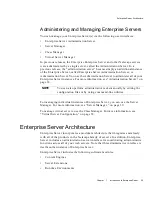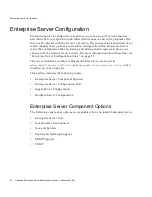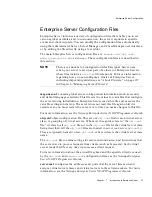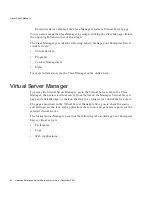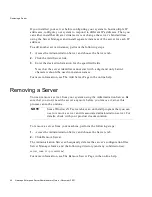
Enterprise Server Configuration
Chapter
1
Introduction to Enterprise Server
33
Enterprise Server Configuration Files
Enterprise Server includes a variety of configuration files that enable you to set
various global variables, and to customize how the server responds to specific
events and client requests. You can modify the configuration files automatically
using the Administrator Server, Server Manager, and Class Manager user interface,
or by editing the files directly using a text editor.
The main Enterprise Server configuration files are:
magnus.conf
,
obj.conf
,
mime.types
,
server.xml
, and
admpw
. These configuration files are described in
this section.
magnus.conf
: contains global server configuration information (such as security
and default language selection). This file sets the values for variables that configure
the server during initialization. Enterprise Server reads this file and executes the
variable settings on startup. The server does not read this file again until it is
restarted, so you must restart the server every time you make changes to this file.
For more information, see the Netscape Enterprise Server NSAPI Programmer’s Guide.
obj.conf
: object configuration file. There is one
obj.conf
file for each virtual server
class, or grouping of virtual servers. Whenever this guide refers to “the
obj.conf
file,” it refers to all
obj.conf
files or to the
obj.conf
file for the virtual server class
being described. All the
obj.conf
files are located in server_root
/
server_id
/config
.
They are typically named vsclass
.obj.conf
, where vsclass is the virtual server class
name.
The
obj.conf
file contains settings for server customization, and instructions that
the server uses to process requests from clients (such as browsers). Each virtual
server reads this file every time it processes a client request.
For more information about the actual file syntax and the specific directives used
by the
obj.conf
and
magnus.conf
configuration files, see the Netscape Enterprise
Server NSAPI Programmer’s Guide.
server.xml
: configures the addresses and ports that the server listens on and
assigns virtual server classes and virtual servers to these listen sockets. For more
information, see the Netscape Enterprise Server NSAPI Programmer’s Guide.
NOTE
There are a number of configuration files Enterprise Server uses
when your server is set up as part of a cluster of Enterprise Servers
(these files include a .
clfilter
file extension). For more information
regarding how you can configure a cluster of Enterprise Server,
including important guidelines, see “About Clusters,” on page 137
in Chapter 6, “Managing Server Clusters.”
Summary of Contents for NETSCAPE ENTREPRISE SERVER 6.0 - ADMINISTRATOR
Page 1: ...Administrator s Guide Netscape Enterprise Server Version6 0 November 2001...
Page 18: ...18 Netscape Enterprise Server Administrator s Guide November 2001...
Page 26: ...26 Netscape Enterprise Server Administrator s Guide November 2001...
Page 48: ...Migrating a Server 48 Netscape Enterprise Server Administrator s Guide November 2001...
Page 50: ...50 Netscape Enterprise Server Administrator s Guide November 2001...
Page 146: ...146 Netscape Enterprise Server Administrator s Guide November 2001...
Page 242: ...242 Netscape Enterprise Server Administrator s Guide November 2001...
Page 294: ...294 Netscape Enterprise Server Administrator s Guide November 2001...
Page 332: ...Deleting a Virtual Server 332 Netscape Enterprise Server Administrator s Guide November 2001...
Page 378: ...378 Netscape Enterprise Server Administrator s Guide November 2001...
Page 396: ...Responses 396 Netscape Enterprise Server Administrator s Guide November 2001...
Page 414: ...Posting to JSPs 414 Netscape Enterprise Server Administrator s Guide November 2001...
Page 432: ...Further Information 432 Netscape Enterprise Server Administrator s Guide November 2001...
Page 444: ...444 Netscape Enterprise Server Administrator s Guide November 2001...











